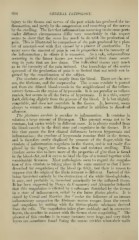Page 684 - My FlipBook
P. 684
694 GENERAL PATHOLOGY.
injury to the tissues and nerves of the part which has produced the in-
flammation, and partly by the compression and stretching of the nerves
by the swelling. The fact that inflammations occurring in the same parts
under diflerent circumstances difl'er very remarkably in this respect
seems to show that the cause has much to do with the production of
pain. This is illustrated by comparison of the pain produced by a plas-
ter of mustard-seed with that caused by a plaster of cantharides. In
many cases the amount of pain is not in proportion to the intensity of
the inflammation ; in others it is excessive. As a rule, inflammations
occurring in the firmer tissues are more painful than those occur-
ring in parts that are less dense. The individual tissues vary much
as to the intensity of the pain induced. Our knowledge of the modus
operandi of the production of pain is so limited that not much can be
gained by the consideration of the subject.
The exudates are derived mostly from the blood. These are the ser-
ous, the fibrinous, and the corpuscular. The serous exudate is poured
out from the dilated blood-vessels in the neighborhood of the inflam-
matory focus—in the region of hypersemia. It is not peculiar to inflam-
mation, but occurs in all the forms of hyperemia. It is a thin, watery
fluid, diflering slightly from the plasma of the blood. It is but slightly
coagulable, and does not coagulute in the tissues. It, however, seems
always to contain some fibriuogenous matter in addition to dissolved
albumen.
The fbrinous exudate is peculiar to inflammation. It contains in
solution a large amount of fibrinogen. This amount seems not to be
constant, but varies widely in different cases. It is always exuded from
the blood-vessels in the fluid state and coagulates in the tissues. It is
this that causes the first clinical diflerences between hypersemia and
inflammation ; the exudate of hyper£emia remains fluid in the tissues,
and is therefore easily displaced by pressure of the flnger, while the
exudate of inflammation coagulates in the tissues, and is not easily dis-
placed by the finger, but forms a firm and resistant swelling. This
exudate seems also to have more of the j)roperties of glue than is found
in the blood-clot, and it serves to bind the lips of a wound together wdth
considerable firmness. Most pathologists seem to regard the coagula-
tion of this exudate as taking place in the same manner as that I have
descril)ed for coagulation of the blood (]). 680) ; but there is reason to
suppose that the origin of the fibrin ferment is diflerent. Instead of this
being furnished entirely by tlie destruction of the white blood-globules,
it may, and probably is, furnished principally by the inflamed tissue.
It has been suggested by Dcnys de Commercy and Alexander Schmidt
that this coagulation is eflected by a substance furnished by the tissues
in a state of inflanunation, called by the latter fihrino-plastin. It is
stated by Cornil and llanvier that " under the influence of an intense
inflannnatory congestion the fil)rin()us matter escapes from the vessels
and coagulates by uniting with the fibrino-plastic substance derived
from the cells. The coagulation takes place suddenly and in successive
layers, the exudate in contact with the tissues alone coagulating." The
amount of this exudate is in many instances very large, and very thick
lavers are sometimes found lining the serous cavities when their walls


